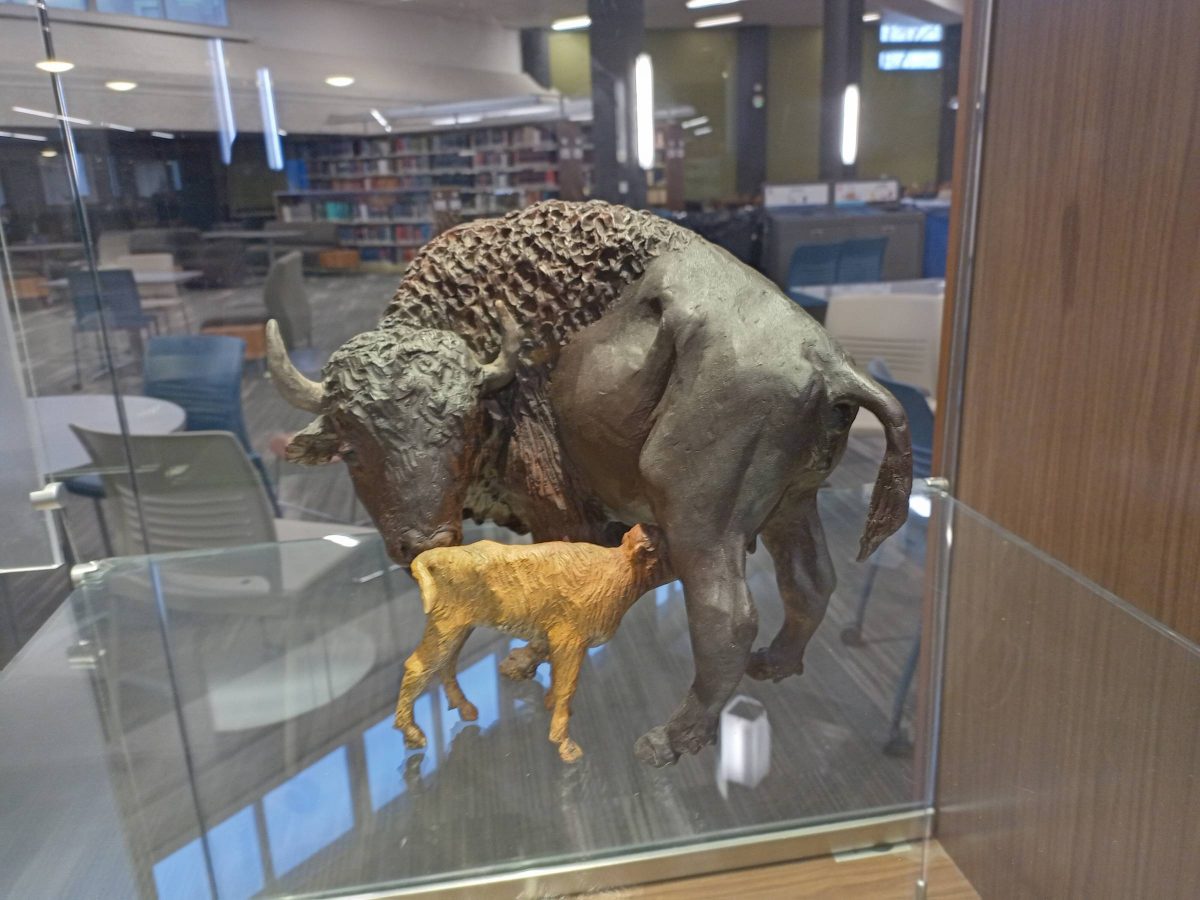
TLC, a painted bronze statue of a female bison and her calf.
Fafard bison sculpture joins the herd
Anita Ross, [BA/64, BA(Hons)/65, MA/66, PhD/72] recently donated a painted bronze sculpture by artist and UM alum Joe Fafard [BFA/66, LLD/07] to the University of Manitoba. The piece, called TLC, is of a female bison and her calf, and it can be found at their new permanent home in the Elizabeth Dafoe Library.
Ross thought UM would be a fitting home for this statue because the traits of the bison have defined the university since 1877. A bison alone stands strong, unyielding to the gusting winds. Bison united create a herd. Together, they move with purpose, driving relentlessly ahead. From students to staff to faculty to researchers, UM is home to bison in numbers greater than ever before, working together to create a brighter future for all.
“I grew up in a family that always had an appreciation for art, and my mother was very artistic,” she says. “I enjoy much of Fafard’s work, but this bison really caught my eye. First, TLC, I thought it was a wonderful title. That’s perfect. But also, my first memories of bison were in my early childhood when, if you walked along Portage Avenue in winter, the policemen were all wearing huge bison coats. Years later when I was a student at UM and the Winnipeg police had changed their outdoor garb, you would see a few male students proudly wearing some of these secondhand bison coats.”
While on campus, Ross spent a huge amount of time in the Elizabeth Dafoe Library, which she dubbed a second home. It seems appropriate that TLC has a new home in this same library. After travelling abroad for her PhD, Ross’ path took a turn from languages and classics to the world of business. She was encouraged to take an interview with the IBM Branch Manager in Winnipeg. She passed the screening and was sent to Toronto where IBM had put together a training program for employees in the Data Processing Division. There, she learned about hardware and software, how to make a sales call, how to write proposals, and more.
“That was a really fascinating time, as I was one of three women out of a class of 35 or so,” says Ross. “I was assigned to the Finance and Insurance branch in Montreal because I had the ability to communicate in both official languages, and this Branch Manager sat me down the first day and said, ‘if you’re going to be in my branch, you have to know a couple of things. First of all, we’re the top branch in the country, and we have to re-earn that every year. So, you have to understand that that’s what you have to live up to.’”
With that determination set at the start of her career, Ross continued to move up through IBM and was eventually named Branch Manager in Saskatchewan, the first woman to hold that title in the Canadian company. It was while there that she became aware of the vibrancy of the artistic community. Ross hadn’t yet discovered Fafard himself, but she knew it was an artist from Saskatchewan who’d created the seven enormous cows that lie on the grass in the TD Centre in Toronto. This grouping is aptly named “The Pasture”.
“Along the way, as I had more and more experience in different areas of the business and had earned a number of promotions, I would treat myself each time with a piece of art,” she says. “I did collect a number of fine paintings from the Group of Seven and their contemporaries, but I also collected other items that were not the usual kind of art. I was fascinated by all the art that surrounds us. When I was working in Vancouver, I had an opportunity to become familiar with a few of the galleries, and it was there I first saw some of Fafard’s pieces.”
During his lifetime, Fafard was a distinguished full-time artist and sculptor who lived his entire life on the Canadian Prairie. In the early 1970s, much of his sculpture used clay as a medium. In 1985, he shifted to bronze as his chief sculptural medium, successfully establishing a foundry in Pense, Saskatchewan. His insight and humour characterized his portraits of neighbours, farm animals, wildlife, well-known politicians, and famous artists whom he came to respect as he learned his craft. His work in bronze is displayed across Canada and his cows became one of his trademarks.
While Ross had enjoyed the TLC piece in her home for many years, she thought it was time to find it a new home where many more people could enjoy seeing it. Naturally, because it’s a bison, she decided quickly on the University of Manitoba.
“It’s such a fine thing to see this huge animal being so nourishing. Of course, that is what university is. It’s a big, multi-faceted entity, and it looks after you,” she says. “I always find art very soothing. If you are feeling troubled at any time, just wandering around museums and galleries can often be a good way to get some air into your head and help you put things in perspective.”
You—our generous UM community—keep showing us how inspiration changes everything.
Whether you are supporting health as a human right, advancing reconciliation and promoting Indigenous achievement, climate change research, or transforming the learning experience, you are making the world a better place.
Read more in our Gratitude Report





